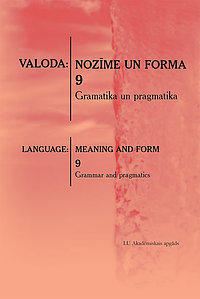Telpas un laika izteiksmes stratēģijas: la. uz priekšu un pa priekšu gadījums
Strategies of expressing spatial and temporal relations: the cases of Latvian uz priekšu ‘ahead, frontward’ and pa priekšu ‘fore’
Author(s): Daiva Kardelīte-Grinevičiene, Vytautas KardelisSubject(s): Language studies, Semantics, Cognitive linguistics
Published by: Latvijas Universitātes Akadēmiskais apgāds
Keywords: room; time; forward; first; inner origo; exterior origo;
Summary/Abstract: Based on the combination of methods of referential and cognitive semantics, the article deals with one part of the model of the expression of spatial and temporal relations, namely the saggital and its realisation in discourse. The study compares the realisations of saggital relations expressed by the adverbial priekin ‘ahead, frontward’ in the Vilniškiai subdialect of Northeast Aukštaitija with the realisation of such relations by Latvian adverbials uz priekšu ‘ahead, frontward’ and pa priekšu ‘fore’ in discourse. The Vilniškiai subdialect of Northeast Aukštaitija features a prototypical and non-prototypical use of the adverbial priekin. In its prototypical use, it refers to spatial movement (‘forward in the direction of movement’, ahead / frontward’). When the meaning of the adverbial is transferred to the temporal domain, the adverbial priekin is used in its non-prototypical meaning to refer to an earlier time of events (‘in advance’ or ‘earlier, previously, before’). The main goal of the analysis of Latvian data was to find out whether a similar model of prototypical and non-prototypical uses of the adverbial also exists in the Latvian language. Having reviewed the strategies of conceptualising spatial and temporal relations, the paper also aimed at determining whether the realisations of Latvian adverbials uz priekšu and pa priekšu in discourse feature strategies of text-external and text-internal origo. The analysis of the use of Latvian adverbials uz priekšu and pa priekšu found in dictionaries and corpora revealed that their prototypical realisations in discourse are based on the strategy of the text-external origo and they correspond to the realisations of priekin in Lithuanian. Examples of non-prototypical uses of these adverbials which, applying the strategy of textinternal origo, refer to an earlier time of events (‘in advance’, ‘earlier, previously, before’) were not identified. As a result, based of the analysis of Latvian data, it is fair to state that the Lithuanian adverbial priekin in its sense of ‘in advance’, ‘earlier, previously, before’) has no parallel in Latvian. A hypothesis that Latvian features the uses of text-internal origo can be proposed on the basis of the analysis of the non-prototypical realisations of the adverbial pa priekšu in temporal scenes. However, this hypothesis needs to be tested and can only be verified by carrying out a separate study by drawing on more extensive linguistic data than that used in the present paper.
Journal: Valoda: nozīme un forma
- Issue Year: 2018
- Issue No: 9
- Page Range: 112-131
- Page Count: 20
- Language: Latvian

